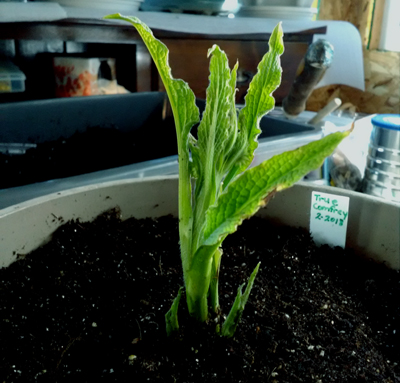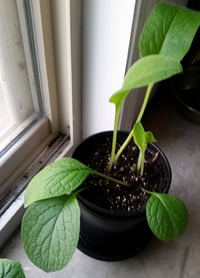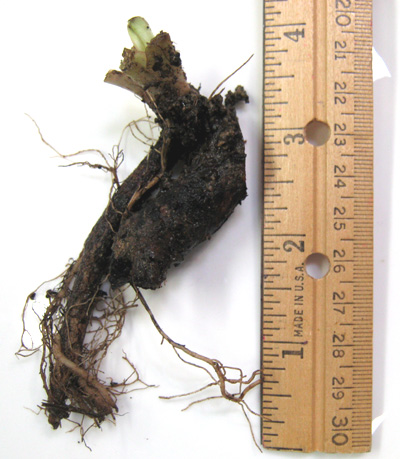Comfrey Container Gardening


|
Growing
Comfrey in Pots
Comfrey will
grow in pots (at least 3 gallon), containers such as plastic tubs, or 5-gallon
plastic buckets but they do better when not grown in a pot. They have deep
roots so prefer growing in the garden where they get more nutrients.
The containers need drainage holes in the bottom. Add fertilizer to the
potting soil. Comfrey especially likes nitrogen. Take care of your comfrey
the same as any potted plant.
"The True Comfrey that I ordered earlier is now
potted and doing well. I had kept it in the fridge for about a month, but
it did not seem to suffer any ill effects. Thank you!" -Cat, Augusta,
Kentucky
 The second photo is from Cat.
The second photo is from Cat.
"I will have a large 10 gallon pot, filled with
compost, some local dirt, and composted manure, waiting for it for its first
home. Then when it grows bigger in a couple months, I will have ready it's
permanent place in the ground ready for it. I hope it does as well as I
feel it will. I have been gardening for years and still wonder why I have
not heard of this wonderful plant before, and it's wonderful uses in the
garden." -Arthur, Breckenridge Hills, Missouri
The photo on the right is Russian Comfrey #14.
"Such happy little plants! Been trimming it back
several times to keep it small in the pot till spring." -John, White
Cloud, Michigan
|


|
Hardy
Comfrey in Containers
"I
wanted to share with you the great experience I have had with your comfrey
roots that I ordered from you last year. We are trying to establish a mini-farm,
and I was not able to plant the roots directly into the ground so I opted
for some 3-gallon planting containers. They were there a lot longer than
I wanted them to be but they grew big and tall."
"Well weeks went by, and I realized that my raised beds were not going to
be in place before the winter so out of desperation I just planted some
of these comfrey plants into the clay soil in front of a barn under construction
with 6 plants still left in their containers."
"Winter came, with lots of traffic around the barn, and all the rain, snow
and freezing cold weather. I am happy to report that when March arrived,
ALL the comfrey plants were wonderfully brought back to life and are THRIVING.
Thank you for a truly hardy and wonderfully useful plant." -Soilfully,
James Chapman, Judson Farm, Culberson, NC
|


Volume 2:
Cultivation of Comfrey; Medicinal and Food Uses for People and Livestock
|
Comfrey in Grow Bags at 25 Days
"I started them all in a raised bed and then moved them to four gallon grow bags because we are about to move to a new home, and I do not want to leave these behind. I will get them in the ground by the end of the month.
The True Comfrey sprouted 2 out of one root so I split it, they are both doing good just a little shorter as they were about half the size of the single when I split them. They all are growing nicely."
-James, Broward County, Sunrise, Florida
Cultivation of Comfrey; Medicinal and Food Uses for People and Livestock, Volume 2
Chapter 34: Care of Plant Overview and How to Propagate, pages 372-373
"If you need to temporarily store root cuttings in a bag or box, it is much better to have the roots too dry than too wet.
Roots that are too wet quickly rot. Roots that are too dry can last days or weeks depending on how dry it is and on the size of
the root. Of course, planting sooner is always best.
For storage of several months, one method is putting whole plants, with the leaves/stalks cut off, in slightly moist sawdust
and/or peat moss mixture at 35 to 40 F (1.6-4.4 C) degrees.
The ideal is a temperature-controlled storage room of the type used by farmers who grow vegetables and perennials. Or you
could store them in a root cellar."
“Temporary and New Comfrey Beds: Root cuttings are a great way to plant out large areas of Comfrey. The cuttings
should be grown on in small pots with 50% compost, 50% river sand mix, kept moist, and planted out in the spring as soon as
the first leaves emerge and the soil has warmed.
If you are planting large numbers of root cuttings, you can plant directly into the beds by creating 'nests' in the straw, adding
two cupped handfuls of the above mentioned potting mix and plant the cuttings into this. Keep them moist like a wrung out
sponge, and the success rate will be very close to 100%.”
-‘Comfrey: Its History, Uses and Benefits’ by Paul Alfrey, Permaculture Magazine: Earth Care, People Care, Future Care;
Hampshire, England, www.permaculture.co.uk, March 3 2016.
|

|
Buy Live
Comfrey Roots for Planting
Grow
your own Comfrey: True/Common Comfrey, Russian Bocking #4, Russian Bocking
#14, Symphytum Hidcote Blue.
Your order includes a flyer about how to take care of your plants.
Comfrey
Easy Order Page
|
| |
|


 The second photo is from Cat.
The second photo is from Cat.



